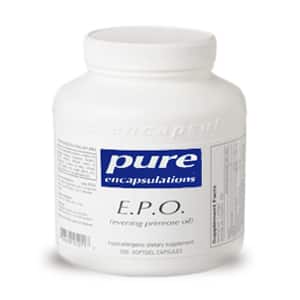Most people judge youth by the look of a person’s skin and try to do all they can to keep it feeling comfortable and looking youthful. But do you know what to do if your skin has a tendency to become dry, red, blistery, scaly, itchy or even crusty? Is lotion the first and only line of defense? Have you considered that there may be treatment from the inside out?
Rather than suffer through uncomfortable skin irritation, its best to learn about natural solutions that can minimize dry skin outbreaks and at least reduce symptoms when they do happen. Whether you experience dry skin or eczema every day, only on occasion, or simply want to be prepared, nature has answers.
What causes dry skin and what is eczema?
Our skin is the largest organ of the body and acts as a protective barrier to keep moisture in and microbes and chemicals out. It also helps regulate body temperature. During this process, water is constantly lost through evaporation as the body is always fine-tuning its temperature.
This process of evaporation and drying of the skin increases or decreases with the environment we live in, changes in humidity, wind, the amount of heat or cold, or even what we do to stay warm or cool down. Additionally, skin becomes more susceptible to dryness with age due to thinning of the outermost layer that retains moisture.
One form of eczema people often encounter is contact dermatitis, which is caused by skin contact with irritants like chemicals, poison ivy or poison oak, detergents, animal dander or pollen, and acidic foods. There is also nummular eczema; in which itchy coin shaped spots appear after being triggered by insect bites or dry skin in the winter.
Dyshidrotic eczema is another form in which itchy blisters form on the hand or feet after experiencing stress or coming into contact with certain metal-plated jewelry or objects. However, when doctors and researchers use the term “eczema,” it generally refers to a common variety known as atopic dermatitis – a chronic form of red, dry skin that usually begins in childhood and often is caused by genetics.
As people get older, the skin naturally loses some of its protective barrier that keeps it smooth and moisturized. Many turn to moisturizers that contain natural solutions such as aloe, but many contain petroleum-based ingredients that can clog pores and cause blemishes for some people.
Fortunately, there is a natural way to help skin keep its moisture and protective barrier from the inside – by increasing your intake of a particular essential fatty acid called gamma linolenic acid (GLA) that can help prevent water loss from the skin, which reduces eczema symptoms like itchiness and scaliness.
What is GLA?
GLA is an essential fatty acid that the body cannot produce by itself, but is required in a person’s diet to maintain healthy skin.
While most people don’t typically consume foods high in GLA, they do consume omega-6 fatty acids which convert into GLA. The problem is that some people have trouble with this conversion process due to genetics and lifestyle factors like smoking, alcohol consumption, stress, vitamin deficiency, and particular diseases and conditions (such as diabetes).
So why not just take more omega-6 fatty acids? After all, they are found in fried and processed foods that are abundant. The reason is because of balance — omega-6 fatty acids must be balanced with omega-3 fatty acids. You can learn more about this concept by reading my previous articles on omega fatty acids and inflammation — How Important is Fish Oil? and How Long-Term Inflammation is Hurting You Now.
However, by supplementing directly with GLA, we can bypass this conversion process and be sure that our skin receives the beneficial effects that GLA has to offer without an overabundance of omega-6 fatty acids.
GLA has been a common component in folk cures and homeopathic remedies for centuries. Native Americans discovered its presence in seeds from the evening primrose plant and used it to reduce swelling. Around the 17th century, evening primrose was introduced to Europe and used for a wide variety of ailments. It was eventually referred to by many as the “king’s cure-all.”
Many studies that have looked at its effects on skin have shown that it can be effective to minimize eczema symptoms by positively influencing skin dryness, inflammation, and the skin’s blood flow.
Does GLA really work?
A study from the Journal of Oleo Science found that GLA intake improves skin in a number of ways for those suffering from dry skin and eczema. The researchers concluded that GLA improves the skin’s protective barrier, which helps it keep moisture in and keep irritants out.
Research from Advances in Therapy looked at how evening primrose oil supplementation increases the levels of GLA found in the blood of the test subjects and how that improves eczema symptoms. The study showed that this supplementation led to significant effects after 4-8 weeks of treatment, and further improvement of symptoms after 12 weeks; leading the researchers to recommend this therapy as a long-term solution for eczema.
While it is great that using supplements to increase GLA levels in the body seems to reduce eczema, are they safe to take long-term like some studies recommend? Most studies that look at boosting GLA levels for addressing eczema note a lack of adverse effects in patients, and a study published the Journal of Oleo Science claimed that long term GLA consumption led to no noteworthy side effects in any of the patients.
Are there any other treatments to consider?
Some moisturizing lotions can be mildly helpful, but only if you select the right one and apply it at the right time. Avoid lotions with alcohol or perfumes, as these tend to only make issues with dry skin and eczema worse. Also be sure to apply the lotion when the skin is still moist so that the lotion has moisture to trap in. Many people only apply lotion when the skin has already become uncomfortably dry, but it is hard for the lotion to do much at that point.
There are other non-natural alternatives to treating eczema and excessively dry skin, such as topical steroids. While these are a common treatment, most research (including a study published in Indian Dermatology Online Journal) shows they can cause thinning of the skin and adversely affect the skin’s connective tissue. This leads to loose, wrinkled, transparent and shiny skin. In addition, topical steroids also cause skin fragility, loss of skin color, and the increased visibility of veins.
People looking to avoid therapies with those kinds of side effects may combine certain popular natural remedies with increased GLA intake. It should be noted that I cannot personally vouch for their efficacy, but such natural solutions include applying coconut or olive oil to the skin (or a mixture of baking soda and water), and taking oatmeal or Epsom salt baths.
Some people say spending time in the ocean helps with eczema; likely because of the magnesium and salt in the water. Those who don’t live near a beach can try making a spray at home, which should bring similar results, using distilled or boiled water, sea salt, and magnesium flakes.
GLA itself can be found in food, but most people don’t commonly eat foods that contain high quantities of it. If you are able to add more foods like hemp oil or spirulina into your diet (it’s easiest to include these in salads and grain dishes), that is ideal. However, many find that it is easier to just find a high-quality GLA supplement to give the body what it needs to avoid dry skin and keep the skin healthy.
Whether you don’t get enough GLA through diet, or do but simply need an extra dose to maintain skin health, supplementing with a high quality GLA can be helpful.
Which GLA supplements should I try?
Evening primrose oil is one of the most common sources of supplemental GLA. One advantage to choosing an evening primrose oil product as your GLA source is that this is the form most often used in the studies that demonstrate GLA’s effectiveness in addressing eczema. A product like E.P.O., by Pure Encapsulations, provides the body with a high-quality, standardized dose GLA.
Some other products use borage oil, derived from a wildflower commonly called starflower, because its extracts have the highest content of GLA of any plant source. Borage Oil, by Vital Nutrients, is a great supplement for those looking to harness the potent GLA that borage oil has to offer.
Whether you are someone who has struggled with eczema in the past or just wants to know how to treat dry skin from the inside instead of lathering up with lotions, I hope this information is useful to you. If you have any questions regarding the concepts discussed here or anything else, you can reach our customer service team at customerservice@oakwaynaturals.com or you can call them at 888-460-3091.
Until next time, stay healthy!
Yours in health,
Dr. Gregg Gittins
www.OakwayNaturals.com












Comments are closed.